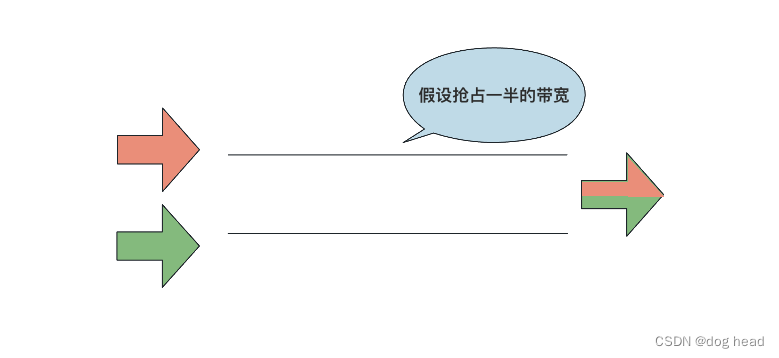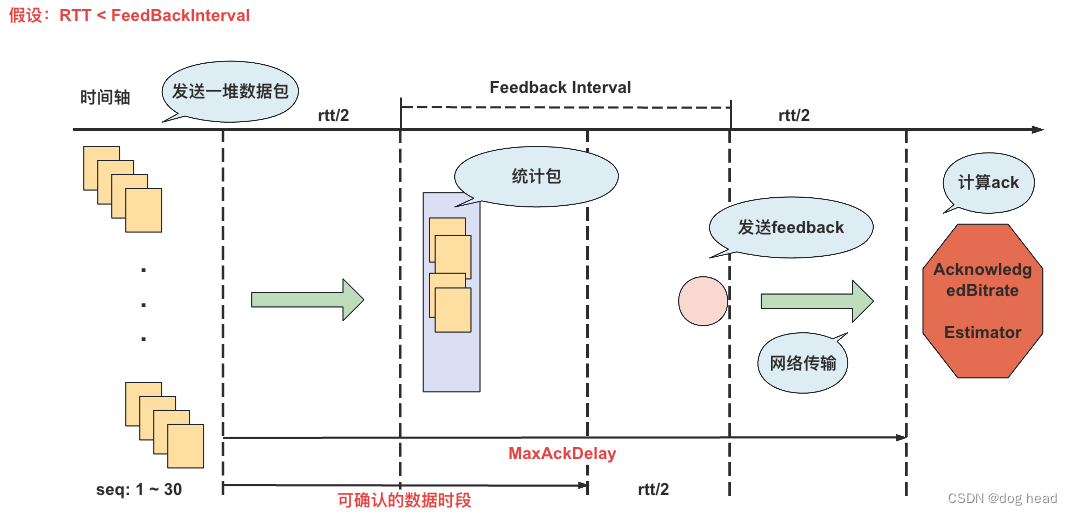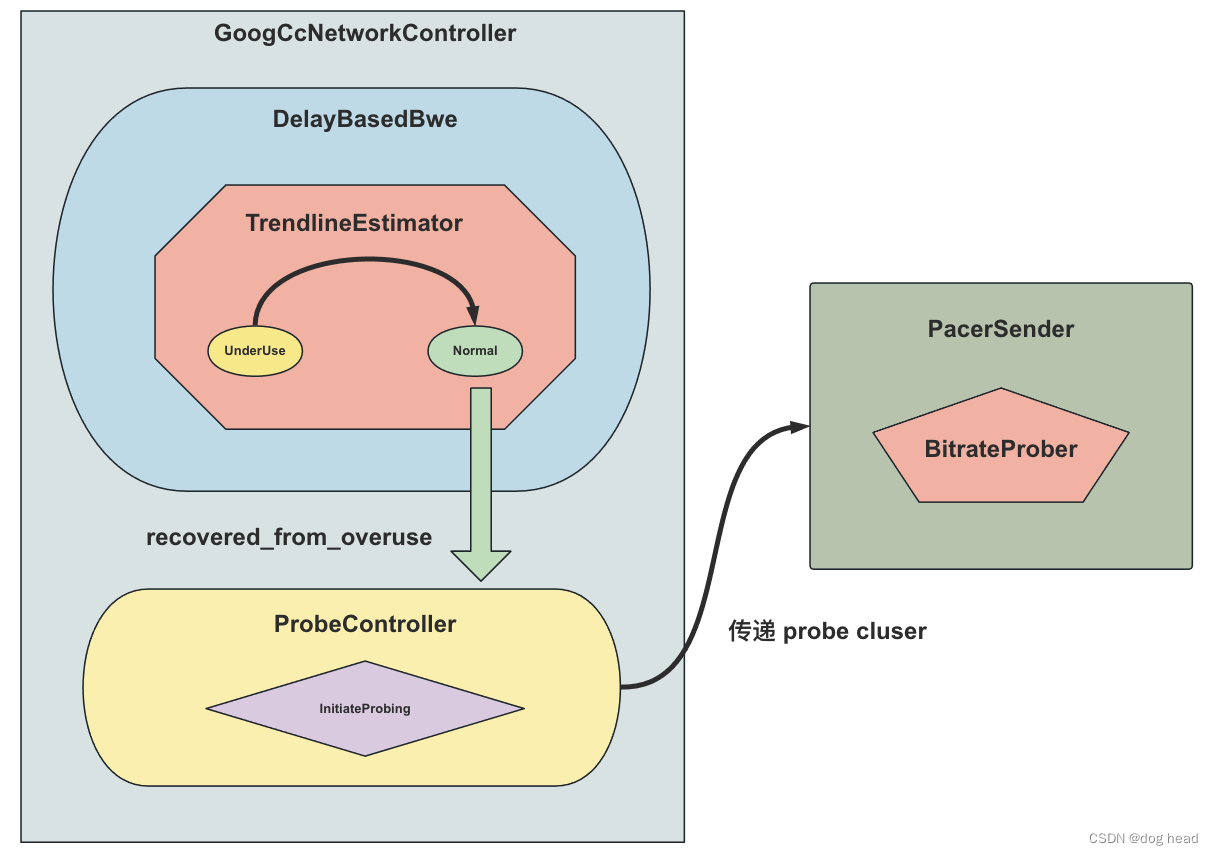流媒体学习之路(WebRTC)——GCC中ProbeBitrateEstimator和AcknowledgedBitrateEstimator的大作用(7)
——
我正在的github给大家开发一个用于做实验的项目 —— github.com/qw225967/Bifrost
目标:可以让大家熟悉各类Qos能力、带宽估计能力,提供每个环节关键参数调节接口并实现一个json全配置,提供全面的可视化算法观察能力。
欢迎大家使用
——
文章目录
- 流媒体学习之路(WebRTC)——GCC中ProbeBitrateEstimator和AcknowledgedBitrateEstimator的大作用(7)
- 一、探测估计与确认估计的意义
- 1.1 BitrateEstimator
- 1.2 再会AcknowledgedBitrateEstimator
- 1.3 ProbeBitrateEstimator
- 1.4 小结
- 二、探测怎么用于码率控制
- 三、总结
在讲具体内容之前插一句嘴,从GCC分析(3)开始,我们将针对GCC的实现细节去分析它设计的原理,让我们理解这些类存在的意义,不再带大家去串具体的流程了。
一、探测估计与确认估计的意义
在GCC探测的过程中,拥塞检测和码率计算是多个模块组成的,在上涨的过程中,涨多少?在下降的过程中,降多少?这是个需要好好思考的问题。例如:我们在传输过程中,传统的有线网络突然发生了严重的拥塞(就假设有个下载任务突然进行竞争),那么大部分的网络被占用了。对端接收的状态如下:

那么对端所接收的数据就只剩一半了,返馈到发送方时会变成 1/2 * send_bitrate。因此统计出该阶段的确认数据为ack_bitrate。
聪明的小伙伴就会发现,我们依赖于这个确认值可以很有效的获得当前网络的吞吐量——但是——这个值是一个滞后的值,滞后的点在于它是上一个feedback周期内的确认值,假设当时发生了拥塞,那么这个值的延迟可能打到1~2s,非常的不靠谱。由此,我们引出我们需要基于这样的采样值,合理的做出估计,用于我们下一步的探测。
1.1 BitrateEstimator
BitrateEstimator这个类是ProbeBitrateEstimator和AcknowledgedBitrateEstimator都会用到的统计类,它最重要的作用就是通过贝叶斯估计,使得码率的统计值更加合理、准确。
当我们在传输过程中,ack的码率不是恒定的,通过贝叶斯估计后将会得到当前ack码率的估计值,我们在脑子里模拟一下这个计算过程或许能得到一些启发:

首先我们假设RTT小于每次feedback定时触发的时长。那么数据包最长的确认延迟为:RTT + FeedbackInterval = MaxAckDelay。而我们可确认的数据则是在Feedback发送前可接收到的所有数据(排除定时发送周期和Feedback发送周期的差,假设它俩严丝合缝),由此可知,统计的ack数据则是:前MaxAckDelay时间 至 前RTT时间 的数据,数据的窗口大小很明显就是一个FeedbackInterval。而当前发送端就需要使用该数据去决策我当前的吞吐量,于是贝叶斯估计的逻辑就起作用了。
下面展示的是窗口更新的逻辑:
float BitrateEstimator::UpdateWindow(int64_t now_ms, int bytes,
int rate_window_ms) {
// Reset if time moves backwards.
// 异常返回
if (now_ms < prev_time_ms_) {
prev_time_ms_ = -1;
sum_ = 0;
current_window_ms_ = 0;
}
// 上一次进行窗口更新之后,进行确认计算,目标就是算出整个计算窗口。
// 这个值rate_window_ms一般就是150
if (prev_time_ms_ >= 0) {
current_window_ms_ += now_ms - prev_time_ms_;
// Reset if nothing has been received for more than a full window.
if (now_ms - prev_time_ms_ > rate_window_ms) {
sum_ = 0;
// 大于默认窗口大小则前面的计算窗口就被干掉了
// 这是因为有可能feedback在传输中丢了,前面的那个窗口啥也没确认
current_window_ms_ %= rate_window_ms;
}
}
prev_time_ms_ = now_ms;
float bitrate_sample = -1.0f;
// 窗口满了就进行计算
if (current_window_ms_ >= rate_window_ms) {
// 大B除以窗口时间,换算成小b进行统计每毫秒的码率值 bit/ms
bitrate_sample = 8.0f * sum_ / static_cast<float>(rate_window_ms);
current_window_ms_ -= rate_window_ms;
sum_ = 0;
}
sum_ += bytes;
return bitrate_sample;
}
从代码中可以看出来,webrtc使用的窗口值是每次feedback接收确认后记录的值来进行ack计算的,而webrtc中默认的feedback发送间隔为50ms一次,那么很快咱们就能想明白,这个150ms是3个feedback之后计算一次ack的采样值(根据上面解释的内容,这个值始终滞后了一个rtt的时间)。
void BitrateEstimator::Update(Timestamp at_time, DataSize amount, bool in_alr) {
// 赋值窗口值
int rate_window_ms = noninitial_window_ms_;
// We use a larger window at the beginning to get a more stable sample that
// we can use to initialize the estimate.
// 初始状态
if (bitrate_estimate_kbps_ < 0.f) rate_window_ms = initial_window_ms_;
// 每次feedback都更新一次,但是满足窗口大小就会输出一个不为-1.0的值
float bitrate_sample_kbps =
UpdateWindow(at_time.ms(), amount.bytes(), rate_window_ms);
// 不满足直接返回
if (bitrate_sample_kbps < 0.0f) return;
// 第一次更新码率
if (bitrate_estimate_kbps_ < 0.0f) {
// This is the very first sample we get. Use it to initialize the estimate.
bitrate_estimate_kbps_ = bitrate_sample_kbps;
return;
}
// Define the sample uncertainty as a function of how far away it is from the
// current estimate. With low values of uncertainty_symmetry_cap_ we add more
// uncertainty to increases than to decreases. For higher values we approach
// symmetry.
// 初始化不确定度,不确定度会被用于计算采样值与估计值之间的偏差
float scale = uncertainty_scale_;
// alr状态下可以调高不确定度,但目前初始化时一样的值,都是 10.
if (in_alr && bitrate_sample_kbps < bitrate_estimate_kbps_) {
// Optionally use higher uncertainty for samples obtained during ALR.
scale = uncertainty_scale_in_alr_;
}
// 计算码率样本的不确定度
// (|历史值 - 样本值| * 不确定度) / 历史值 = 样本不确定度
// 这里的对称性让我百思不得其解,但是后来想了一下,所谓的对称性就是在 bitrate_sample_kbps 同为负值时,就使用负值。
// 那么就会变成 bitrate_estimate_kbps_ - bitrate_sample_kbps 与 bitrate_estimate_kbps_ + bitrate_sample_kbps
// (|历史值 - 样本值| * 不确定度) / 历史值 = 样本不确定度 这个公式得到的是——相对偏差
// (|历史值 - 样本值| * 不确定度) / (历史值 + 样本值) = 这个两个样本的相似度:越接近1,相似度越低;越接近0,相似度越高
float sample_uncertainty =
scale * std::abs(bitrate_estimate_kbps_ - bitrate_sample_kbps) /
(bitrate_estimate_kbps_ +
std::min(bitrate_sample_kbps,
uncertainty_symmetry_cap_.Get().kbps<float>()));
// 求采样不确定度的平方
float sample_var = sample_uncertainty * sample_uncertainty;
// Update a bayesian estimate of the rate, weighting it lower if the sample
// uncertainty is large.
// The bitrate estimate uncertainty is increased with each update to model
// that the bitrate changes over time.
//
float pred_bitrate_estimate_var = bitrate_estimate_var_ + 5.f;
// 根据不确定度进行加权平均:
// 采样的不确定度 * 历史估计值 = 根据历史值推算的当前值 ——> 当前偏差很越小,历史数据可信度低,反之高
// 先验不确定度 * 当前采样值 = 根据历史不确定性推算的当前值 ——> 先验偏差越小,采样数据可信度低,反之高
// 以上两者比值类似于 谁不确定度大,那么码率的占比越低,最终输出一个平均值。
bitrate_estimate_kbps_ = (sample_var * bitrate_estimate_kbps_ +
pred_bitrate_estimate_var * bitrate_sample_kbps) /
(sample_var + pred_bitrate_estimate_var);
// 当前值必须要大于等于0,否则后面没法算了
bitrate_estimate_kbps_ =
std::max(bitrate_estimate_kbps_, estimate_floor_.Get().kbps<float>());
// 贝叶斯公式中:当前采样的不确定度 * 先验的码率不确定度 / (采样不确定度 + 先验码率不确定度) = 当前的估计不确定度
bitrate_estimate_var_ = sample_var * pred_bitrate_estimate_var /
(sample_var + pred_bitrate_estimate_var);
}
上面的注释内容详细讲解了估计的运算原理,在码率计算中,根据我们采样的偏差值与历史偏差值进行运算,等到一个加权的平均码率值,可以很直观的发现:
1.当我们历史的不确定度越大,那么当前采样的可信度就高,那么我们给他的权重就相对高;
2.当我们采样的不确定度越大,那么历史值的可信度就高,那么我们给历史值的权重就高。
1.2 再会AcknowledgedBitrateEstimator
AcknowledgedBitrateEstimator类在前面一篇文章中流媒体学习之路(WebRTC)——GCC分析(3)简单提及,今天我们不执着于这个类的代码解析,而是从它延伸出去看我们整个码率估计系统中,吞吐量计算的逻辑,让我们理解webrtc吞吐量计算中的优点。与它相关的调用关系我列在下方:
// 网络出现变化,重置相关计算类
GoogCcNetworkController::OnNetworkRouteChange() {
...
if (safe_reset_on_route_change_) {
absl::optional<DataRate> estimated_bitrate;
...
// 获取估计码率
estimated_bitrate = acknowledged_bitrate_estimator_->bitrate();
if (!estimated_bitrate)
// 没有估计码率峰值也行
estimated_bitrate = acknowledged_bitrate_estimator_->PeekRate();
}
...
// 重置
acknowledged_bitrate_estimator_.reset(
new AcknowledgedBitrateEstimator(key_value_config_));
}
NetworkControlUpdate GoogCcNetworkController::OnSentPacket(
SentPacket sent_packet) {
...
// 编码器进入alr状态
acknowledged_bitrate_estimator_->SetAlr(
alr_detector_->GetApplicationLimitedRegionStartTime().has_value());
...
}
NetworkControlUpdate GoogCcNetworkController::OnTransportPacketsFeedback(
TransportPacketsFeedback report) {
...
if (previously_in_alr_ && !alr_start_time.has_value()) {
int64_t now_ms = report.feedback_time.ms();
// 根据feedback adapt统计后的信息判断是否进入了AlrEndTime
acknowledged_bitrate_estimator_->SetAlrEndedTime(report.feedback_time);
probe_controller_->SetAlrEndedTimeMs(now_ms);
}
...
// 把feedback放入计算
acknowledged_bitrate_estimator_->IncomingPacketFeedbackVector(
report.SortedByReceiveTime());
auto acknowledged_bitrate = acknowledged_bitrate_estimator_->bitrate();
...
}
上面的东西没啥特别的,主要是Alr状态的判断。当Alr状态的时候,我们的码率是无法输出到达我们的预期的,但是当它离开时很可能码率立马上涨,此时的bitrate estimate中我们提到的采样差值可能会剧烈上涨,但是算法加权之后权重下降了,因此我们要在SetAlrEndedTime 的时候调用一下 BitrateEstimator::ExpectFastRateChange() 让它的历史差增大快速适应这个差值变化。
void BitrateEstimator::ExpectFastRateChange() {
// By setting the bitrate-estimate variance to a higher value we allow the
// bitrate to change fast for the next few samples.
bitrate_estimate_var_ += 200;
}
1.3 ProbeBitrateEstimator
ProbeBitrateEstimator的逻辑相对AcknowledgedBitrateEstimator就复杂一些,WebRTC把每一次探测归类为群组(cluster),然后通过统计每次发送的时间和内容进行计算探测。
struct AggregatedCluster {
// 探测包数
int num_probes = 0;
// 第一个发送包时间
Timestamp first_send = Timestamp::PlusInfinity();
// 最后一个发送包时间
Timestamp last_send = Timestamp::MinusInfinity();
// 第一个包到达时间
Timestamp first_receive = Timestamp::PlusInfinity();
// 最后一个包到达时间
Timestamp last_receive = Timestamp::MinusInfinity();
// 最后发送包大小
DataSize size_last_send = DataSize::Zero();
// 第一个接收包大小
DataSize size_first_receive = DataSize::Zero();
// 总大小
DataSize size_total = DataSize::Zero();
};
处理探测的逻辑如下:
absl::optional<DataRate> ProbeBitrateEstimator::HandleProbeAndEstimateBitrate(
const PacketResult& packet_feedback) {
int cluster_id = packet_feedback.sent_packet.pacing_info.probe_cluster_id;
// RTC_DCHECK_NE(cluster_id, PacedPacketInfo::kNotAProbe);
EraseOldClusters(packet_feedback.receive_time);
AggregatedCluster* cluster = &clusters_[cluster_id];
// 取出所有数据
if (packet_feedback.sent_packet.send_time < cluster->first_send) {
cluster->first_send = packet_feedback.sent_packet.send_time;
}
if (packet_feedback.sent_packet.send_time > cluster->last_send) {
cluster->last_send = packet_feedback.sent_packet.send_time;
cluster->size_last_send = packet_feedback.sent_packet.size;
}
if (packet_feedback.receive_time < cluster->first_receive) {
cluster->first_receive = packet_feedback.receive_time;
cluster->size_first_receive = packet_feedback.sent_packet.size;
}
if (packet_feedback.receive_time > cluster->last_receive) {
cluster->last_receive = packet_feedback.receive_time;
}
cluster->size_total += packet_feedback.sent_packet.size;
cluster->num_probes += 1;
// RTC_DCHECK_GT(
// packet_feedback.sent_packet.pacing_info.probe_cluster_min_probes, 0);
// RTC_DCHECK_GT(packet_feedback.sent_packet.pacing_info.probe_cluster_min_bytes,
// 0);
// 最小探测包接收数:kMinReceivedProbesRatio 为 0.8 * 最小发送包数
int min_probes =
packet_feedback.sent_packet.pacing_info.probe_cluster_min_probes *
kMinReceivedProbesRatio;
// 最小接收包大小
DataSize min_size =
DataSize::bytes(
packet_feedback.sent_packet.pacing_info.probe_cluster_min_bytes) *
kMinReceivedBytesRatio;
// 探测包数太少、不符合运算要求直接返回
if (cluster->num_probes < min_probes || cluster->size_total < min_size)
return absl::nullopt;
// 发送间隔
TimeDelta send_interval = cluster->last_send - cluster->first_send;
// 接收间隔
TimeDelta receive_interval = cluster->last_receive - cluster->first_receive;
// // TODO: TMP
// MS_WARN_DEV(
// "-------------- probing cluster result"
// " [cluster id:%d]"
// " [send interval:%s]"
// " [receive interval:%s]",
// cluster_id,
// ToString(send_interval).c_str(),
// ToString(receive_interval).c_str());
// TODO: TMP WIP cerdo to avoid that send_interval or receive_interval is
// zero.
//
// if (send_interval <= TimeDelta::Zero())
// send_interval = TimeDelta::ms(1u);
// if (receive_interval <= TimeDelta::Zero())
// receive_interval = TimeDelta::ms(1u);
// 发送间隔异常返回
if (send_interval <= TimeDelta::Zero() || send_interval > kMaxProbeInterval ||
receive_interval <= TimeDelta::Zero() ||
receive_interval > kMaxProbeInterval) {
return absl::nullopt;
}
// Since the |send_interval| does not include the time it takes to actually
// send the last packet the size of the last sent packet should not be
// included when calculating the send bitrate.
// RTC_DCHECK_GT(cluster->size_total, cluster->size_last_send);
// 发送时间内的大小计算
DataSize send_size = cluster->size_total - cluster->size_last_send;
// 计算发送率
DataRate send_rate = send_size / send_interval;
// Since the |receive_interval| does not include the time it takes to
// actually receive the first packet the size of the first received packet
// should not be included when calculating the receive bitrate.
// RTC_DCHECK_GT(cluster->size_total, cluster->size_first_receive);
// 接收间隔内的大小计算
DataSize receive_size = cluster->size_total - cluster->size_first_receive;
// 计算接收率
DataRate receive_rate = receive_size / receive_interval;
// 接收率/发送率 过大(大于2)则异常,直接返回
double ratio = receive_rate / send_rate;
if (ratio > kMaxValidRatio) {
return absl::nullopt;
}
// 去发送、接收的小值作为探测到的结果
DataRate res = std::min(send_rate, receive_rate);
// If we're receiving at significantly lower bitrate than we were sending at,
// it suggests that we've found the true capacity of the link. In this case,
// set the target bitrate slightly lower to not immediately overuse.
// 当接收码率小于90%的发送码率,则认为网络出现了异常,将会返回更低的探测值(当前探测值 * 95%)防止它下一步进入overuse状态
if (receive_rate < kMinRatioForUnsaturatedLink * send_rate) {
// RTC_DCHECK_GT(send_rate, receive_rate);
res = kTargetUtilizationFraction * receive_rate;
}
last_estimate_ = res;
estimated_data_rate_ = res;
return res;
}
探测的逻辑中我们需要避免造成网络异常拥塞,因此对各类异常情况进行类确认。在最后的逻辑中,当接收码率小于发送码率的90%,可以确定当前发生拥塞的概率很大,因此需要降低我们的发送码率为当前的95%(目前还不知道这个95%是怎么定的)。计算的逻辑只是探测很小的一部分,探测的逻辑涉及了很多位置——pacer中也有很多实现,我们展开看看其他部分是怎么决定开始探测,又怎么保证它影响最小的?
先确定什么时候会进入探测状态?
1.网络初始化阶段,需要探测到最新的网络状态;
2.在UnderUse状态切换到Normal时,并处于无码率增长状态且降码率不足5s时,认定为需要快恢复状态,则立刻探测。
上面的初始化就不用过多介绍了,但第二个逻辑是在 probe_controller.cc 中进行判断的,而判断 RequestProbe 这个函数的调用在 GoogCcNetworkController::OnTransportPacketsFeedback 函数的最下面的位置:
// modules/congestion_controller/goog_cc/goog_cc_network_control.cc
NetworkControlUpdate GoogCcNetworkController::OnTransportPacketsFeedback(
TransportPacketsFeedback report) {
...
// 这个结果在detecter里做的
recovered_from_overuse = result.recovered_from_overuse;
...
if (recovered_from_overuse) {
probe_controller_->SetAlrStartTimeMs(alr_start_time);
auto probes = probe_controller_->RequestProbe(report.feedback_time.ms());
update.probe_cluster_configs.insert(update.probe_cluster_configs.end(),
probes.begin(), probes.end());
} else if (backoff_in_alr) {
// If we just backed off during ALR, request a new probe.
auto probes = probe_controller_->RequestProbe(report.feedback_time.ms());
update.probe_cluster_configs.insert(update.probe_cluster_configs.end(),
probes.begin(), probes.end());
}
}
// modules/congestion_controller/goog_cc/probe_controller.cc
std::vector<ProbeClusterConfig> ProbeController::RequestProbe(
int64_t at_time_ms) {
// Called once we have returned to normal state after a large drop in
// estimated bandwidth. The current response is to initiate a single probe
// session (if not already probing) at the previous bitrate.
//
// If the probe session fails, the assumption is that this drop was a
// real one from a competing flow or a network change.
bool in_alr = alr_start_time_ms_.has_value();
bool alr_ended_recently =
(alr_end_time_ms_.has_value() &&
at_time_ms - alr_end_time_ms_.value() < kAlrEndedTimeoutMs);
if (in_alr || alr_ended_recently || in_rapid_recovery_experiment_) {
if (state_ == State::kProbingComplete) {
uint32_t suggested_probe_bps =
kProbeFractionAfterDrop * bitrate_before_last_large_drop_bps_;
uint32_t min_expected_probe_result_bps =
(1 - kProbeUncertainty) * suggested_probe_bps;
int64_t time_since_drop_ms = at_time_ms - time_of_last_large_drop_ms_;
int64_t time_since_probe_ms = at_time_ms - last_bwe_drop_probing_time_ms_;
if (min_expected_probe_result_bps > estimated_bitrate_bps_ &&
time_since_drop_ms < kBitrateDropTimeoutMs &&
time_since_probe_ms > kMinTimeBetweenAlrProbesMs) {
// Track how often we probe in response to bandwidth drop in ALR.
// RTC_HISTOGRAM_COUNTS_10000(
// "WebRTC.BWE.BweDropProbingIntervalInS",
// (at_time_ms - last_bwe_drop_probing_time_ms_) / 1000);
last_bwe_drop_probing_time_ms_ = at_time_ms;
return InitiateProbing(at_time_ms, {suggested_probe_bps}, false);
}
}
}
return std::vector<ProbeClusterConfig>();
}
可以看出,ProbeBitrateEstimator是为了支持在码率输出不足的情况下,去做补充和填充的。
1.4 小结
上面我们介绍了两个类存在的意义,首先他们都是利用较短的时间、较少的包数量去估算可能达到的带宽上限。要注意的是——它们代表的不是这一秒钟或者这一段时间完整的带宽情况,而是根据当前估算周期内,计算出来的瞬时速率,是个估计值并不是它们真的在某一秒钟发送了巨量的数据做的探测,因此它们对带宽的消耗是较小的、同时也损失了一定的准确度。
二、探测怎么用于码率控制
本章我们单独把探测的逻辑拿出来好好说一下,因为webrtc的探测逻辑让我感受到是个非常灵活、收放自如的助手工具,怎么做到这点的呢?本章会好好解释。下图展示涉及到探测的模块关系图:

在pacer中,prober的概念是做状态的控制,在决定做探测时它根据cluster的数据进行精细的控制(也可以直接调用创建cluser进行探测)。在起始阶段,它直接创建了cluster进行探测:
// modules/congestion_controller/goog_cc/goog_cc_network_control.cc
// 在每次网络可用的时候进行网络带宽探测
NetworkControlUpdate GoogCcNetworkController::OnNetworkAvailability(
NetworkAvailability msg) {
NetworkControlUpdate update;
// 创建探测configs
update.probe_cluster_configs = probe_controller_->OnNetworkAvailability(msg);
return update;
}
// modules/congestion_controller/goog_cc/probe_controller.cc
std::vector<ProbeClusterConfig> ProbeController::OnNetworkAvailability(
NetworkAvailability msg) {
network_available_ = msg.network_available;
// kWaitingForProbingResult 的意义是等待探测结果的状态
if (!network_available_ && state_ == State::kWaitingForProbingResult) {
state_ = State::kProbingComplete;
min_bitrate_to_probe_further_bps_ = kExponentialProbingDisabled;
}
// 网络处于初始状态时,初始化探测指数
if (network_available_ && state_ == State::kInit && start_bitrate_bps_ > 0)
return InitiateExponentialProbing(msg.at_time.ms());
return std::vector<ProbeClusterConfig>();
}
std::vector<ProbeClusterConfig> ProbeController::InitiateExponentialProbing(
int64_t at_time_ms) {
// RTC_DCHECK(network_available_);
// RTC_DCHECK(state_ == State::kInit);
// RTC_DCHECK_GT(start_bitrate_bps_, 0);
// When probing at 1.8 Mbps ( 6x 300), this represents a threshold of
// 1.2 Mbps to continue probing.
// first_exponential_probe_scale 数值为3.0,探测目标为3倍的初始码率
std::vector<int64_t> probes = {static_cast<int64_t>(
config_.first_exponential_probe_scale * start_bitrate_bps_)};
// second_exponential_probe_scale 二次探测指数为6.0,探测目标更大
if (config_.second_exponential_probe_scale) {
probes.push_back(config_.second_exponential_probe_scale.Value() *
start_bitrate_bps_);
}
return InitiateProbing(at_time_ms, probes, true);
}
std::vector<ProbeClusterConfig> ProbeController::InitiateProbing(
int64_t now_ms, std::vector<int64_t> bitrates_to_probe,
bool probe_further) {
// 默认最大探测码率限制
int64_t max_probe_bitrate_bps =
max_bitrate_bps_ > 0 ? max_bitrate_bps_ : kDefaultMaxProbingBitrateBps;
if (limit_probes_with_allocateable_rate_ &&
max_total_allocated_bitrate_ > 0) {
// If a max allocated bitrate has been configured, allow probing up to 2x
// that rate. This allows some overhead to account for bursty streams,
// which otherwise would have to ramp up when the overshoot is already in
// progress.
// It also avoids minor quality reduction caused by probes often being
// received at slightly less than the target probe bitrate.
max_probe_bitrate_bps =
std::min(max_probe_bitrate_bps, max_total_allocated_bitrate_ * 2);
}
// 创建 pending 探测,创建的内容根据探测的码率数组创建cluster
std::vector<ProbeClusterConfig> pending_probes;
for (int64_t bitrate : bitrates_to_probe) {
// RTC_DCHECK_GT(bitrate, 0);
// 最大码率限制,到达最大码率限制之后只能等进一步的码率探测
if (bitrate > max_probe_bitrate_bps) {
bitrate = max_probe_bitrate_bps;
probe_further = false;
}
// 探测配置
ProbeClusterConfig config;
config.at_time = Timestamp::ms(now_ms);
// dchecked_cast 就是个static_cast
config.target_data_rate = DataRate::bps(rtc::dchecked_cast<int>(bitrate));
// 最小探测间隔 kMinProbeDurationMs 15ms
config.target_duration = TimeDelta::ms(kMinProbeDurationMs);
// 探测目标包数,最小为 kMinProbePacketsSent 5个
config.target_probe_count = kMinProbePacketsSent;
config.id = next_probe_cluster_id_;
next_probe_cluster_id_++;
// 日志打印
MaybeLogProbeClusterCreated(config);
pending_probes.push_back(config);
}
time_last_probing_initiated_ms_ = now_ms;
// 需要进行进一步码率探测则更新码率
if (probe_further) {
state_ = State::kWaitingForProbingResult;
// 获取进一步的最小探测码率
min_bitrate_to_probe_further_bps_ =
(*(bitrates_to_probe.end() - 1)) * config_.further_probe_threshold;
} else {
// 否则探测码率为0,立即进行探测
state_ = State::kProbingComplete;
min_bitrate_to_probe_further_bps_ = kExponentialProbingDisabled;
}
return pending_probes;
}
这里的逻辑是运算我们每次需要探测的码率大小,默认就是5个包。但是有个疑问,为什么即规定了5个包又设置了目标的估计码率呢?具体的逻辑我们需要从pacer中看看:
// 在RtpTransportControllerSend::PostUpdates函数,pacer和gcc两个类关联了起来
// pacer根据gcc计算出来的configs,创建cluster
void PacedSender::CreateProbeCluster(int bitrate_bps, int cluster_id) {
// TODO: REMOVE
// MS_DEBUG_DEV("---- bitrate_bps:%d, cluster_id:%d", bitrate_bps,
// cluster_id);
prober_.CreateProbeCluster(bitrate_bps, loop_->get_time_ms_int64(),
cluster_id);
}
void BitrateProber::CreateProbeCluster(int bitrate_bps, int64_t now_ms,
int cluster_id) {
// RTC_DCHECK(probing_state_ != ProbingState::kDisabled);
// RTC_DCHECK_GT(bitrate_bps, 0);
// 探测次数记录
total_probe_count_++;
// 移除超时cluster
while (!clusters_.empty() &&
now_ms - clusters_.front().time_created_ms > kProbeClusterTimeoutMs) {
clusters_.pop();
total_failed_probe_count_++;
}
// 根据config创建cluster
ProbeCluster cluster;
cluster.time_created_ms = now_ms;
cluster.pace_info.probe_cluster_min_probes = config_.min_probe_packets_sent;
cluster.pace_info.probe_cluster_min_bytes =
static_cast<int32_t>(static_cast<int64_t>(bitrate_bps) *
config_.min_probe_duration->ms() / 8000);
// RTC_DCHECK_GE(cluster.pace_info.probe_cluster_min_bytes, 0);
cluster.pace_info.send_bitrate_bps = bitrate_bps;
cluster.pace_info.probe_cluster_id = cluster_id;
clusters_.push(cluster);
// If we are already probing, continue to do so. Otherwise set it to
// kInactive and wait for OnIncomingPacket to start the probing.
if (probing_state_ != ProbingState::kActive)
probing_state_ = ProbingState::kInactive;
// TODO (ibc): We need to send probation even if there is no real packets, so
// add this code (taken from `OnIncomingPacket()` above) also here.
if (probing_state_ == ProbingState::kInactive && !clusters_.empty()) {
// Send next probe right away.
next_probe_time_ms_ = -1;
// 开启探测状态
probing_state_ = ProbingState::kActive;
}
// TODO: jeje
TODO_PRINT_PROBING_STATE();
}
当我们创建完cluster之后就会进入到探测状态,在每次定时器调用时会确认当前是否需要进行探测,这部分的逻辑为:
void PacedSender::Process() {
int64_t now_us = loop_->get_time_ms_int64();
int64_t elapsed_time_ms = UpdateTimeAndGetElapsedMs(now_us);
if (paused_) return;
if (elapsed_time_ms > 0) {
int target_bitrate_kbps = pacing_bitrate_kbps_;
media_budget_.set_target_rate_kbps(target_bitrate_kbps);
UpdateBudgetWithElapsedTime(elapsed_time_ms);
}
// 需要开启探测
if (!prober_.IsProbing()) return;
PacedPacketInfo pacing_info;
absl::optional<size_t> recommended_probe_size;
// 获取当前的cluster
pacing_info = prober_.CurrentCluster();
recommended_probe_size = prober_.RecommendedMinProbeSize();
size_t bytes_sent = 0;
// MS_NOTE: Let's not use a useless vector.
std::shared_ptr<bifrost::RtpPacket> padding_packet{nullptr};
// Check if we should send padding.
while (true) {
// 获取需要padding的码率
size_t padding_bytes_to_add =
PaddingBytesToAdd(recommended_probe_size, bytes_sent);
if (padding_bytes_to_add == 0) break;
// TODO: REMOVE
// MS_DEBUG_DEV(
// "[recommended_probe_size:%zu, padding_bytes_to_add:%zu]",
// *recommended_probe_size, padding_bytes_to_add);
// 根据需要产生的padding码率获取padding包
padding_packet = packet_router_->GeneratePadding(padding_bytes_to_add);
// TODO: REMOVE.
// MS_DEBUG_DEV("sending padding packet [size:%zu]",
// padding_packet->GetSize());
// 发送padding包
packet_router_->SendPacket(padding_packet.get(), pacing_info);
bytes_sent += padding_packet->GetSize();
// 发送的码率超过探测码率则退出
if (recommended_probe_size && bytes_sent > *recommended_probe_size) break;
}
// 剩余padding不足也退出
if (bytes_sent != 0) {
auto now = loop_->get_time_ms_int64();
// 更新padding记录
OnPaddingSent(now, bytes_sent);
prober_.ProbeSent((now + 500) / 1000, bytes_sent);
}
}
size_t PacedSender::PaddingBytesToAdd(
absl::optional<size_t> recommended_probe_size, size_t bytes_sent) {
// Don't add padding if congested, even if requested for probing.
// 正在拥塞直接返回
if (Congested()) {
return 0;
}
// MS_NOTE: This does not apply to mediaproxy.
// We can not send padding unless a normal packet has first been sent. If we
// do, timestamps get messed up.
// if (packet_counter_ == 0) {
// return 0;
// }
// 计算需要的码率
if (recommended_probe_size) {
if (*recommended_probe_size > bytes_sent) {
return *recommended_probe_size - bytes_sent;
}
return 0;
}
return padding_budget_.bytes_remaining();
}
三、总结
ProbeBitrateEstimator和AcknowledgedBitrateEstimator两个类是gcc做码率控制的基础,webrtc对AcknowledgedBitrateEstimator的修改较少,但是对Probe相关的类一直在做调整。上面展示的m77代码和我最近看的m105代码差距就已经发生明显的变化。在Pacer中,m105增加了线程控制而且产生padding包的逻辑也做了调整。同时在触发探测的逻辑上也进行多处修改。但是我们根据上述的代码走读,也理解了webrtc在设计中的思想,它们把观测值通过数学的方式转化成较为可靠的估计值,并且在不断的优化数学方法,我们可以考虑用到当前的一些统计上面。




